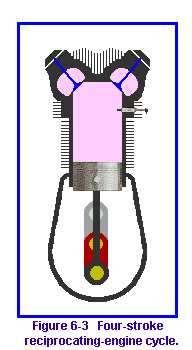 |
|||||
| Home | Research | For Teachers | HISTORY Level 1 Level 2 Level 3 |
PRINCIPLES Level 1 Level 2 Level 3 |
CAREER Level 1 Level 2 Level 3 |
| Gallery | Hot Links | What's New! | |||
| Web Administration and Tools | |||||
 |
|||||
| Home | Research | For Teachers | HISTORY Level 1 Level 2 Level 3 |
PRINCIPLES Level 1 Level 2 Level 3 |
CAREER Level 1 Level 2 Level 3 |
| Gallery | Hot Links | What's New! | |||
| Web Administration and Tools | |||||
| The cylinder is closed on one end (the cylinder head), and the
piston fits snugly in the cylinder. The piston wall is grooved to accommodate rings which
fit tightly against the cylinder wall and help seal the cylinder's open end so that gases
cannot escape from the combustion chamber. The combustion chamber is the area between the
top of the piston and the head of the cylinder when the piston is at its uppermost point
of travel. The up-and-down movement of the piston is converted to rotary motion to turn the propeller by the connecting rod and the crankshaft, just as in most automobiles. Note the crankshaft, connecting rod, and piston arrangement in Figure 6-3 and imagine how the movement of the piston is converted to the rotary motion of the crankshaft. Note particularly how the connecting rod is joined to the crankshaft in an offset manner. The valves at the top of the cylinder open and close to let in a mixture of fuel and air and to let out, or exhaust, burned gases from the combustion chamber. The opening and closing of a valve are done by a cam geared to the crankshaft. This gearing arrangement ensures that the two valves open and close at the proper times. |
 |
Send all comments to ![]() aeromaster@eng.fiu.edu
aeromaster@eng.fiu.edu
© 1995-98 ALLSTAR Network. All rights reserved worldwide.
| Funded in part by | From Civil Air Patrol Educational Materials |
Updated: February 23, 1999